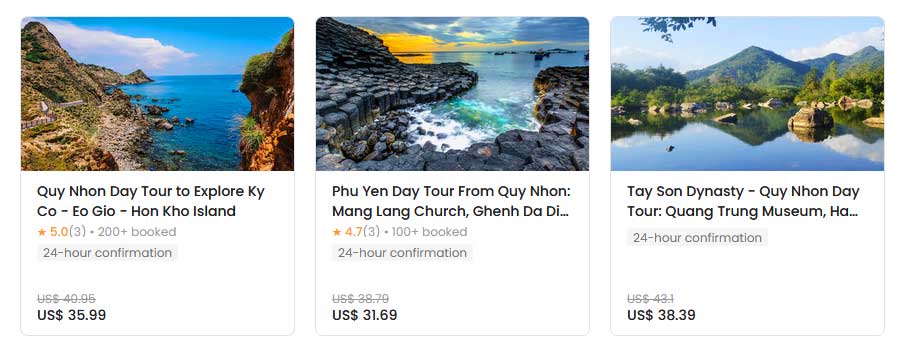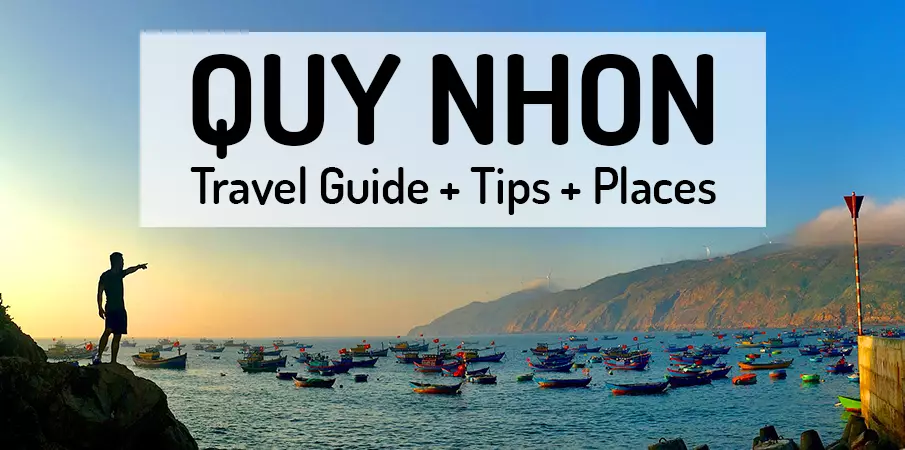
ℹ️ Information – Quy Nhon
✈️ How to get to Quy Nhon
☀️ Weather in Quy Nhon
🏡 Where to stay in Quy Nhon
🔍 Sightseeing in Quy Nhon
❓ FAQ + Travel Tips + Info
🎫 Book a Tour in Quy Nhon
🎫 Book Ticket to Quy Nhon
Quick answer: Quy Nhơn is a charming, underrated coastal city in central Vietnam, known for its calm beaches, dramatic cliffs, and rich Cham history. It’s a relaxed destination where you can combine beach time, cultural landmarks, and local seafood — ideal for travelers wanting to explore off the beaten path.
At a glance:
- 🏖️ Beaches: Relax at Ky Co Beach or Bai Xép, both peaceful and scenic.
- 🌊 Cliff Views: Hike or drive to Eo Gió for stunning rocky coastlines.
- 📜 Cham Heritage: Visit ancient towers like Tháp Đôi and Banh It.
- 🏞️ Fishing Villages: Explore Nhon Hải or Bai Xép for local life and seafood.
- ⛴️ Island Snorkeling: Take a boat to Hon Kho for coral reefs and clear water.
- 🍤 Food: Enjoy fresh seafood and local specialties like fish noodle soup.
- ✈️ Getting There: Fly into Phu Cat Airport or use the nearby train station.
- 🕰️ Best Time to Visit: December–April offers good weather and calm seas.
Last updated in November 2025
Location and Geography of Quy Nhon:
-
- Quy Nhon is a coastal city situated in the Binh Dinh province of central Vietnam. The city is located on the south-central coast of Vietnam, approximately 320 kilometers (200 miles) south of Da Nang city and 230 kilometers (143 miles) north of Nha Trang city.
- Quy Nhon is surrounded by a beautiful natural landscape that includes mountains, beaches, and islands. The city is situated on a small peninsula that extends out into the South China Sea, with the Thi Nai Lagoon to the north and the Nhon Ly Island to the south. The city has a tropical monsoon climate, with hot and humid summers and mild winters. The average temperature ranges from 24°C (75°F) to 28°C (82°F) throughout the year, with the rainy season occurring from September to December.
- Quy Nhon is known for its beautiful beaches, which are characterized by their turquoise waters and soft white sand. Some of the most popular beaches in Quy Nhon include Bai Xep, Ghenh Rang, and Queen. The city is also home to the Quy Nhon Port, which serves as an important transportation hub for the region.
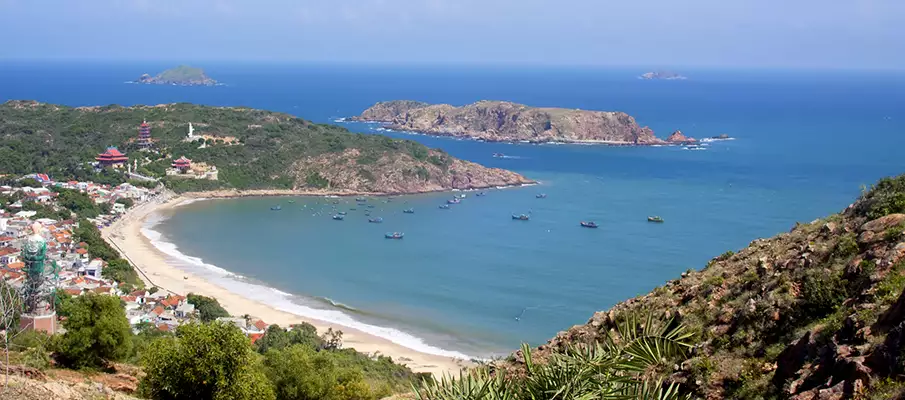
Quy Nhon: A City with a Storied Past and a Vibrant Future:
-
- Quy Nhon has a rich and fascinating history that spans over two thousand years. The area was originally inhabited by the Cham people, an ancient civilization that flourished in central and southern Vietnam from the 2nd to the 17th century. The Cham people built a number of temples and other structures in the region, including the Thap Doi Cham Towers, which are still standing today.
- In the 17th century, the Vietnamese took control of the region and established a port in Quy Nhon, which became an important center for trade and commerce. During the French colonial period, Quy Nhon continued to grow as a major trading hub, exporting goods such as rice, pepper, and cotton. In the 20th century, Quy Nhon played a significant role in the Vietnam War. The city was an important military base for the South Vietnamese and American forces, and was heavily bombed during the conflict. Today, visitors can still see the scars of war in the form of bomb craters and damaged buildings.
- After the war ended, Quy Nhon began to rebuild and develop its economy. The city has since become a major center for tourism, attracting visitors from around the world with its stunning beaches, rich culture, and delicious cuisine. In recent years, Quy Nhon has undergone significant urban development, with new hotels, resorts, and infrastructure projects transforming the city into a modern and vibrant destination. Despite these changes, however, Quy Nhon remains deeply connected to its history and heritage, and continues to honor its past while embracing its future.
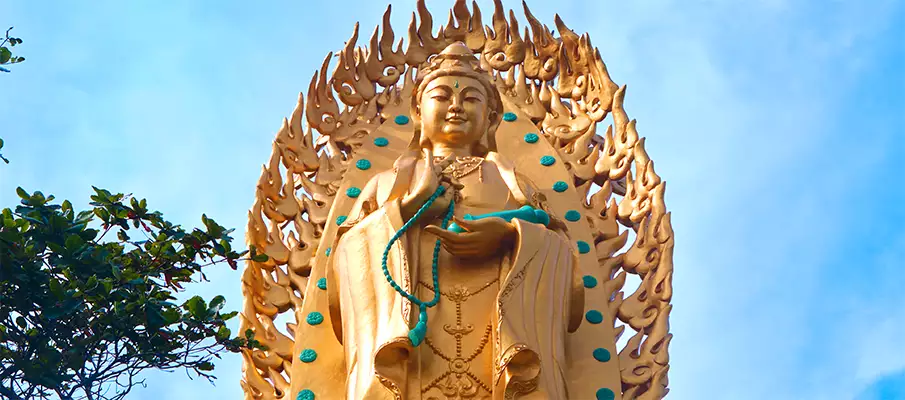
Exploring the Cultural Heritage of Quy Nhon:
-
- Quy Nhon is a city with a rich cultural heritage that reflects its long and fascinating history. The city has been influenced by various cultures and civilizations throughout the centuries, including the Cham, Vietnamese, and French.
- One of the most significant cultural heritage sites in Quy Nhon is the Thap Doi Cham Towers, a group of ancient Cham temples that date back to the 11th century. These temples are known for their beautiful architecture, intricate carvings, and historical significance.
- Quy Nhon is also home to a number of museums and cultural centers, including the Quy Nhon Museum, which showcases the city’s history and culture through a collection of artifacts and exhibits. Another important aspect of Quy Nhon’s cultural heritage is its cuisine. The city is famous for its delicious seafood, including grilled squid, shrimp, and fish. Other popular dishes include banh xeo (Vietnamese pancakes) and nem lui (lemongrass skewers).
- In addition, Quy Nhon is known for its traditional handicrafts, such as pottery, weaving, and woodcarving. Visitors can explore local markets and workshops to see these crafts being made by skilled artisans.
BOOK a TOUR / ACTIVITY in Quy Nhon ➜

Quy Nhon’s Growing Tourism Industry:
-
- Quy Nhon has emerged as a popular tourist destination in Vietnam in recent years, thanks to its stunning beaches, rich cultural heritage, and peaceful atmosphere. The city offers a range of attractions and activities that appeal to travelers of all ages and interests.
- One of the main draws of Quy Nhon is its beautiful beaches. The city is home to several pristine stretches of sand, including Bai Xep, Ghenh Rang, and Queen, which offer opportunities for swimming, sunbathing, beach relax, fun and water sports.
- For those interested in outdoor activities, Quy Nhon offers opportunities for hiking, biking, and exploring the surrounding natural landscape. The Eo Gio Pass, located just outside the city, offers stunning views of the coastline and is a popular spot for hiking and photography.
- In recent years, Quy Nhon has also developed a reputation as a wellness destination, with a number of resorts and spas offering yoga, meditation, and other wellness activities. Overall, Quy Nhon’s tourism industry has been growing rapidly, with new hotels, restaurants, and attractions opening up to meet the demands of visitors from around the world. Despite this growth, however, the city has managed to maintain its laid-back and authentic charm, making it a must-visit destination for anyone traveling to Vietnam.
Book your Accommodation in Quy Nhon ➜
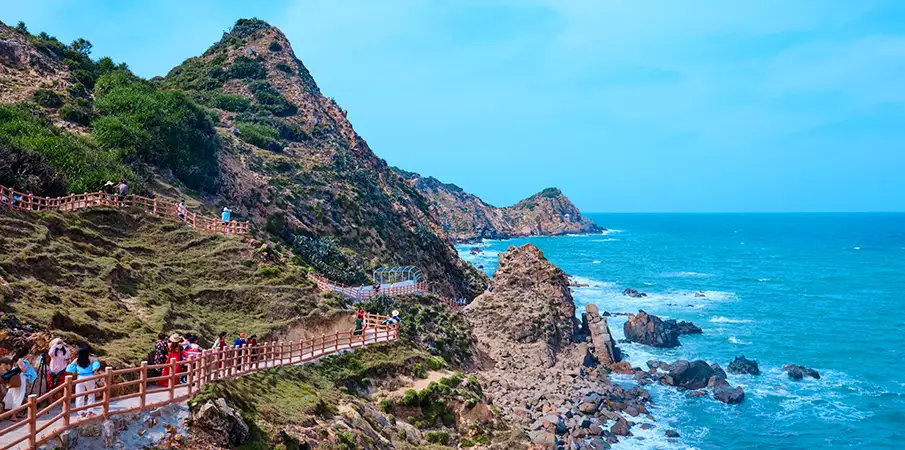
Explore the Ky Co Beach and Eo Gio Cape in Quy Nhon:
-
- Ky Co Beach and Eo Gio Cape are two popular tourist attractions located near Quy Nhon, a coastal city in central Vietnam. Ky Co Beach is a secluded and picturesque stretch of sand surrounded by towering cliffs and crystal-clear waters. It is located on the eastern side of Quy Nhon, on the southern tip of the Thi Nai peninsula. Visitors can reach the beach by taking a boat ride from the nearby fishing village of Xuan Hai.
- Eo Gio Cape, on the other hand, is a scenic coastal road that offers stunning views of the sea and surrounding landscape. It is located just a few kilometers from Quy Nhon and is a popular spot for hiking and photography. Both Ky Co Beach and Eo Gio Cape are known for their natural beauty and serene atmosphere, and are popular destinations for visitors looking to explore the stunning coastline of central Vietnam. You can travel to this site by private taxi or teoretically you can rent a scooter or motorbike.
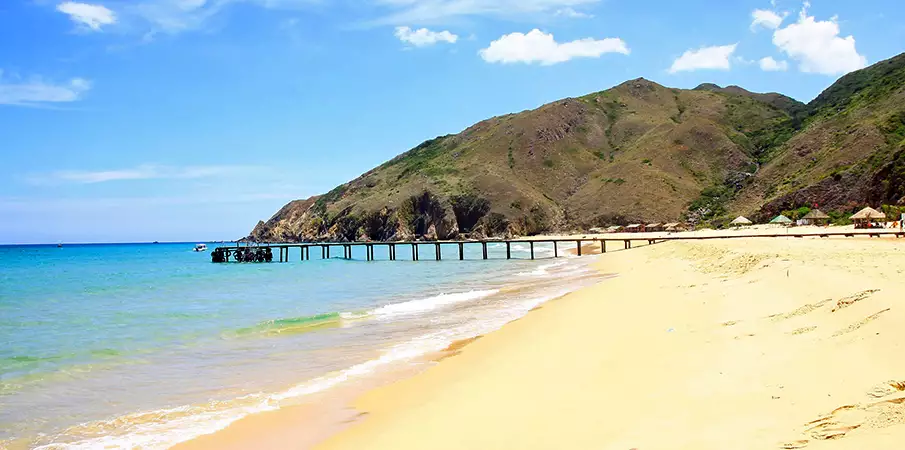
Vung Chua Mountain: A Spiritual and Scenic Gem in Quy Nhon:
Nestled near the enchanting city of Quy Nhơn, Vung Chua Mountain (Núi Vũng Chua), also known as Vung Chua-Yen Island, is a remarkable destination offering a rich tapestry of experiences. This captivating site seamlessly blends spiritual significance, natural beauty, history, and culture.
-
- At the core of Vung Chua Mountain lies a sacred shrine dedicated to Han Mac Tu, a celebrated Vietnamese scholar and poet. This spiritual haven attracts pilgrims and visitors, who come to soak in the profound aura and breathtaking views of the surrounding landscape.
- The mountain’s lush greenery and panoramic vistas of the South China Sea create a picturesque setting that beckons nature enthusiasts and photographers. Vung Chua Mountain stands as a testament to the captivating beauty of the Vietnamese coastline.
- This mountain carries the weight of history as a former naval base during the Vietnam War. Visitors can explore remnants of this period, such as bunkers and tunnels, offering a unique glimpse into the region’s past.
- Ascending to the summit rewards hikers and outdoor enthusiasts with sweeping vistas of Quy Nhơn city, the pristine coastline, and nearby islands. It’s an adventure that combines natural beauty and historical intrigue.
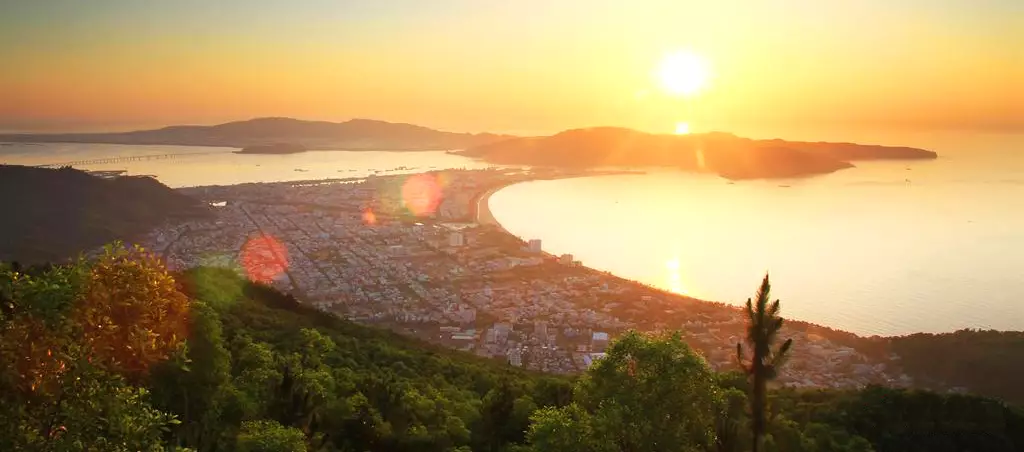
Nhơn Hải district: Discover Quy Nhơn’s Hidden Gem:
-
- Nhơn Hải, a charming coastal district nestled within the city of Quy Nhơn in Bình Định Province, Vietnam, offers an idyllic escape for travelers seeking the perfect blend of traditional coastal life and natural beauty.
- Located in the southeastern part of Quy Nhơn, Nhơn Hải is renowned for its vibrant fishing village, where local livelihoods revolve around the abundant seafood from the South China Sea. The district’s picturesque landscape, with sandy beaches, lush coconut groves, and rolling hills, has started to capture the attention of tourists looking for a quieter alternative to the city center.
- Nhơn Hải also plays a significant role in aquaculture, with many farms cultivating fish, shrimp, and crabs in its brackish water lagoons and ponds. It’s a place where you can immerse yourself in local culture, witnessing the daily routines of fishermen and savoring the freshest seafood at local eateries.
- For those seeking adventure, Nhơn Hải serves as a gateway to nearby islands such as Cu Lao Xanh and Cu Lao Cham, offering pristine beaches and excellent opportunities for snorkeling and scuba diving.
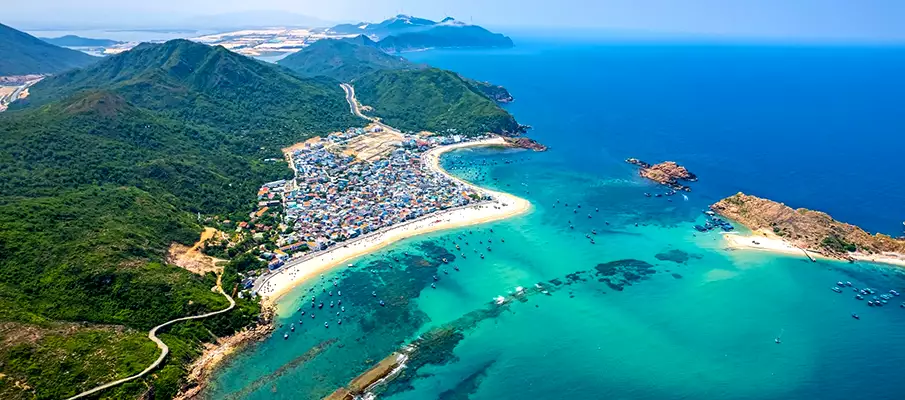
Explore the Beauty of Quy Nhon´s beaches:
Quy Nhon, a coastal city in central Vietnam, is home to several stunning beaches, each with its own unique charm and attractions. Here is a list of some of the most popular beaches in Quy Nhon:
-
- Bai Xep Beach: Located about 13 kilometers south of Quy Nhon, Bai Xep is a picturesque and secluded beach surrounded by lush green hills. The beach is known for its calm and clear waters, making it a popular spot for swimming and snorkeling.
- Quy Nhon Beach: Also known as Bai Dai Beach, is a popular urban beach located in the heart of Quy Nhon city, in central Vietnam. It is a long and wide stretch of golden sand that extends for several kilometers along the city’s coast, with clear blue waters that are ideal for swimming and water sports.
- Ghenh Rang Beach: This beautiful beach is located on a hillside just outside of Quy Nhon and offers stunning views of the surrounding landscape. Visitors can enjoy swimming, sunbathing, and exploring the nearby caves and temples.
- Queen Beach: As its name suggests, this beach is fit for royalty, with its clear blue waters and white sand. The beach is located near the city center and is a popular spot for swimming and sunbathing.
- Ky Co Beach: This secluded and picturesque beach is located on the southern tip of the Thi Nai peninsula and is known for its crystal-clear waters and towering cliffs. Visitors can enjoy swimming, snorkeling, and hiking to nearby hills for panoramic views.
- Quy Hoa Beach: This long and wide beach is located just north of Quy Nhon and is known for its golden sand and calm waters. Visitors can enjoy swimming, sunbathing, and taking a stroll along the beach.
All of these beaches offer a range of activities, from water sports and snorkeling to hiking and exploring nearby attractions. Visitors to Quy Nhon will have plenty of options for enjoying the beautiful coastline and stunning natural landscape of this charming city.
BOOK a TOUR / ACTIVITY in Quy Nhon ➜
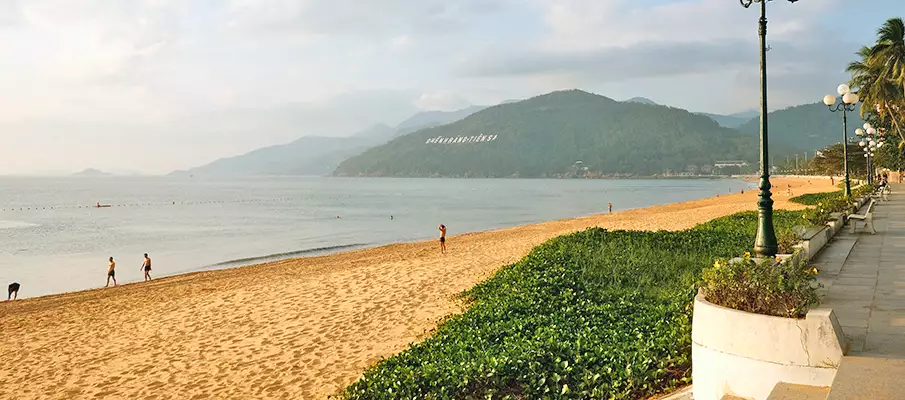
ExploraScience Quy Nhon: Unveiling the Wonders of Science.
Vietnam’s coastal city of Quy Nhon has long been known for its pristine beaches, stunning landscapes, and rich cultural heritage. But now, it’s gaining recognition for something else – the remarkable world of science brought to life at ExploraScience Quy Nhon. ExploraScience Quy Nhon is not your typical science museum. It’s a vibrant, interactive space where curiosity knows no bounds, and visitors of all ages can embark on a thrilling journey of discovery. This innovative science center, which opened its doors in 2022, is a testament to Vietnam’s commitment to education, scientific exploration, and public engagement.
-
- Immersive Exhibits: The heart of ExploraScience Quy Nhon lies in its captivating exhibits. From the mysteries of the cosmos to the wonders of the natural world, the center offers a range of hands-on displays that make science accessible and enjoyable. Whether you’re interested in physics, biology, astronomy, or chemistry, there’s something here to pique your curiosity. One of the most striking features is the „Ocean Odyssey“ exhibit. Being in a coastal city, it’s no surprise that the ocean plays a central role in ExploraScience. Visitors can embark on a virtual journey to the depths of the sea, exploring marine life, coral reefs, and the impact of climate change on the ocean’s ecosystems. This immersive experience fosters awareness and respect for the environment.
- STEM Education: ExploraScience Quy Nhon doesn’t stop at entertaining visitors; it also has a strong educational mission. The center hosts educational programs and workshops that cater to school groups, families, and even adults looking to expand their knowledge. These programs inspire the next generation of scientists and engineers, emphasizing the importance of science, technology, engineering, and mathematics (STEM) fields.
- A Hub for Innovation: Beyond its exhibits and educational programs, ExploraScience Quy Nhon serves as a hub for innovation and research. Collaborations with local universities, scientists, and researchers have resulted in cutting-edge experiments and exhibits that delve into emerging scientific fields, ensuring that the center remains at the forefront of science communication.

Why to visit or not to visit Quy Nhon?
If you are traveling to southern Vietna, it is really a good idea to visit this site for e.g. 3 days. Here are some reasons why you may want to consider visiting Quy Nhon, as well as some reasons why you might want to skip it:
👉 Reasons to visit Quy Nhon:
-
- Beautiful beaches: Quy Nhon is home to several beautiful beaches, including the Bai Xep, Ghenh Rang, and Ky Co beaches. These beaches offer clear waters, soft sand, and stunning views, making them perfect for swimming, sunbathing, and water sports.
- Delicious seafood: Quy Nhon is known for its fresh seafood, which can be enjoyed at local restaurants and markets. Some popular seafood dishes in Quy Nhon include grilled squid, fish cakes, and fish noodles.
- Historical attractions: Quy Nhon has a rich history and several historical sites, including the Quy Nhon City Museum, the Binh Dinh Museum, and the Tay Son Museum. Additionally, the city has several temples and pagodas that reflect its cultural heritage.
- Natural attractions: Quy Nhon is surrounded by beautiful natural scenery, including the Phuong Mai Peninsula, the Thi Nai Lagoon, and the Eo Gio cliff. These areas offer opportunities for hiking, exploring caves, and admiring stunning views of the coastline and countryside.
👉 Reasons not to visit Quy Nhon:
-
- Limited tourist infrastructure: Quy Nhon is still a relatively undiscovered destination, so the tourist infrastructure is not as developed as in some other cities in Vietnam. This may be a concern for some travelers who are looking for more amenities and services. But it is already changing slowly.
- Language barrier: English is not widely spoken in Quy Nhon, so communication with locals may be difficult for travelers who do not speak Vietnamese.
- Limited nightlife: Quy Nhon does not have a lively nightlife scene, so travelers who are looking for entertainment after dark may be disappointed.
- Weather: Quy Nhon can be quite hot and humid, especially during the summer months. Additionally, the city can be prone to typhoons and heavy rain during the rainy season, which runs from September to December.
Overall, Quy Nhon can be a great destination for travelers who are interested in beautiful beaches, fresh seafood, and historical and natural attractions. However, those who are looking for a more developed tourist infrastructure or a lively nightlife scene may want to consider other destinations in Vietnam.
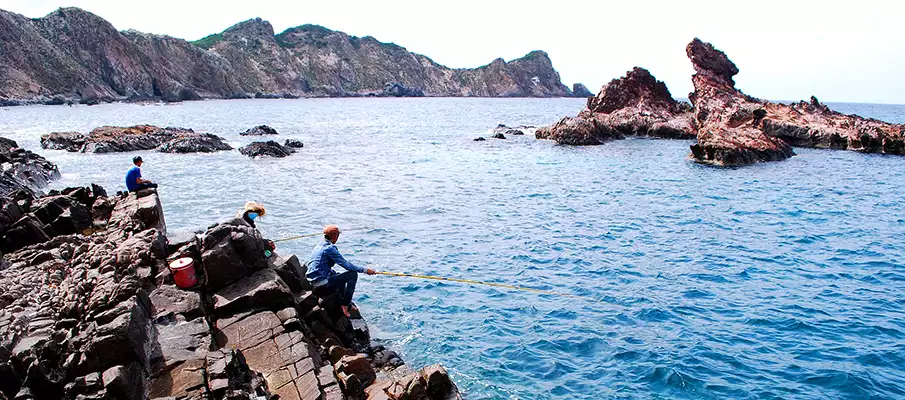
Exploring the Local Food and Cuisine in Quy Nhon:
The cuisine in Quy Nhon, a coastal city in central Vietnam, is known for its fresh seafood and unique flavors. Here are some of the most popular dishes and specialties in Quy Nhon:
-
- Banh Xeo: This is a crispy Vietnamese pancake made with rice flour, turmeric, coconut milk, and stuffed with shrimp, pork, and bean sprouts.
- Bun Cha Ca: A noodle soup with fish cakes, often made with mackerel, and served with fresh herbs and vegetables.
- Banh Canh: A thick and chewy noodle soup made with tapioca flour, served with various meats or seafood.
- Cha Ca: A grilled or fried fish dish served with rice noodles, fresh herbs, and peanuts. Nem Chua: A fermented pork roll made with garlic, chili, and rice, often served as a snack or appetizer.
- Oc Huong: A type of sea snail that is popular in Quy Nhon and served with chili and lemongrass.
- Ca Phe Sua Da: A traditional Vietnamese iced coffee served with sweetened condensed milk. In addition to these dishes, Quy Nhon is also known for its fresh seafood, including crabs, squid, and clams, which can be found at the city’s many seafood restaurants and markets. Overall, the cuisine in Quy Nhon is a must-try for food lovers, with its unique flavors and fresh ingredients that showcase the best of Vietnam’s culinary traditions.
Book your Accommodation in Quy Nhon ➜
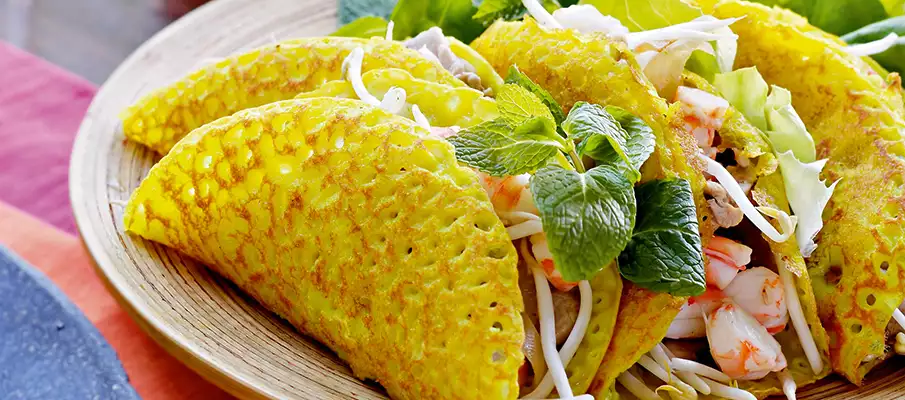
✈️ How to get and travel to Quy Nhon?
Quy Nhon is accessible by land and also by airplane to Phu Cat Airport. There are also trains to Dieu Tri Station or Quy Nhon Station, most of these trains arrive to Dieu Tri. There are also tourist buses from central or southern Vietnam, so the transportation to Quy Nhon is easy.
-
- By Plane: The easiest and quickest way to get to Quy Nhon is by flying into Phu Cat Airport, which is located about 30 minutes from the city center. There are several daily flights from major cities in Vietnam such as Hanoi, Ho Chi Minh City, and Danang. Flight is the most comfortable and fast option of transfer to Quy Nhon.
-
- By Train: Quy Nhon is also accessible by train, with daily services from Hanoi, Ho Chi Minh City, and other major cities in Vietnam. The Dieu Tri train station is located about 10 minutes from the city center, and you can take a taxi or motorbike taxi to get to your hotel.
-
- By Bus: Another option is to take a bus to Quy Nhon, with frequent services from cities such as Hanoi, Ho Chi Minh City, Da Nang or Nha Trang. The bus station is located in the city center, and you can easily take a taxi or motorbike taxi to your accommodation.
- You can book and buy tickets / flights to Quy Nhon on Baolau ➜ or 12go.asia ➜.

☀️ Weather in Quy Nhon + The best time to visit:
-
- Quy Nhon has a tropical monsoon climate, which is characterized by high temperatures, humidity, and distinct wet and dry seasons. ➜ Current weather in Quy Nhon.
- The dry season in Quy Nhon runs from January to August, with the driest months being February, March, and April. During this time, the weather is generally sunny and dry, with warm temperatures ranging from 22°C to 34°C. The sea is also calmer during this period, making it ideal for water-based activities such as swimming, surfing, and snorkeling.
- The wet season in Quy Nhon runs from September to December, with the heaviest rainfall occurring in October and November. During this period, the weather is generally more humid, and there is a higher chance of typhoons and storms. However, the countryside is lush and green, and the rainforests are at their most vibrant, making it a beautiful time to visit for nature lovers.
- Overall, Quy Nhon has a warm and humid climate throughout the year, which makes it a great destination for beach-goers and outdoor enthusiasts. The dry season from January to August is the best time to visit Quy Nhon, but even during the wet season, there are still plenty of activities and attractions to enjoy.
| Month | Weather | Description |
|---|---|---|
| January | Cool and Dry | In January, Quy Nhơn experiences cool and dry weather. The average high temperature is around 25°C (77°F), and the low temperature is approximately 20°C (68°F). It’s an ideal time for beach activities, exploring Ky Co Beach, and enjoying fresh seafood. |
| February | Cool and Dry | February continues with cool and dry conditions. The average high temperature remains around 26°C (79°F), and lows are around 20°C (68°F). The pleasant weather is perfect for visiting the Cham temples, discovering local culture, and taking boat trips to nearby islands. |
| March | Mild and Dry | March brings mild and dry weather to Quy Nhơn. The average high temperature is about 28°C (82°F), and lows are around 22°C (72°F). It’s a wonderful time to explore the beautiful coastline, relax on Ky Co Beach, and enjoy water sports and outdoor activities. |
| April | Warm and Dry | In April, Quy Nhơn experiences warm and dry conditions. The average high temperature is around 31°C (88°F), and lows are approximately 25°C (77°F). It’s an excellent time for beach relaxation, snorkeling, and exploring the scenic landscapes around Bai Xep Beach. |
| May | Warm and Humid | May continues with warm and humid weather. The average high temperature hovers around 33°C (91°F), and lows are around 26°C (79°F). The humidity increases as the monsoon season approaches. Despite occasional rain, May offers lush landscapes and vibrant local life to explore. |
| June | Hot and Humid | June experiences hot and humid weather. The average high temperature is about 35°C (95°F), and lows are approximately 27°C (81°F). The rainfall increases, but there are also periods of sunshine. June is a quieter month for tourists, allowing for peaceful beach experiences. |
| July | Hot and Humid | July remains hot and humid in Quy Nhơn. The average high temperature is around 35°C (95°F), and lows are around 27°C (81°F). The rain is more frequent, but it usually comes in short bursts. July is a good time to explore local markets and engage in water sports. |
| August | Hot and Humid | August continues with hot and humid weather. The average high temperature hovers around 35°C (95°F), and lows are around 27°C (81°F). The rainfall is more consistent, but it rarely affects beach and water activities. August is an ideal time to explore hidden beaches and local fishing villages. |
| September | Hot and Humid | September experiences hot and humid weather, with an average high of about 34°C (93°F) and lows of 27°C (81°F). The rain is more frequent, but it usually comes in short, refreshing showers. It’s a good time for beach relaxation and exploring Quy Nhơn’s cultural attractions. |
| October | Warm and Dry | October continues with warm and dry conditions. The average high temperature is around 31°C (88°F), and lows are around 25°C (77°F). The weather is suitable for beach activities, visiting the Twin Towers of the Ho Dynasty, and exploring local markets. |
| November | Cool and Dry | In November, Quy Nhơn experiences cool and dry weather. The average high temperature remains around 28°C (82°F), and lows are around 22°C (72°F). The comfortable weather makes it an excellent time for beach relaxation, exploring historic sites, and discovering local cuisine. |
| December | Cool and Dry | December brings cool and dry weather to Quy Nhơn. The average high temperature hovers around 26°C (79°F), and lows are about 20°C (68°F). It’s a great time to enjoy the tranquility of the beaches, engage in water sports, and explore the vibrant local life. |
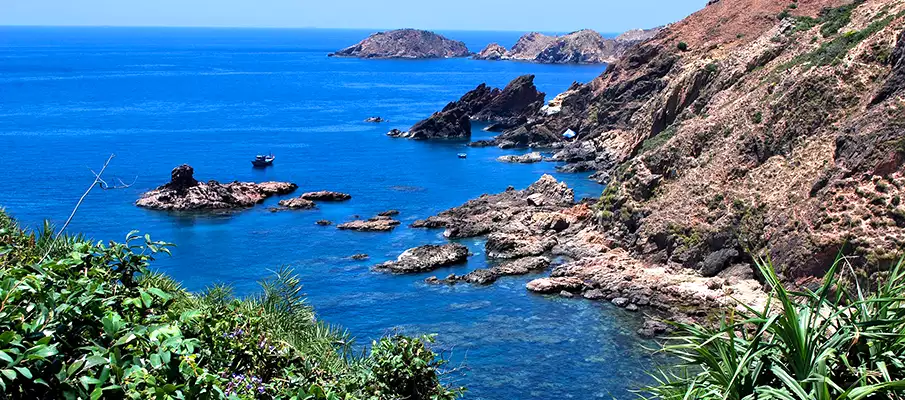
🏡 Where to accommodate in Quy Nhon:
Quy Nhon has a variety of accommodation options to suit different budgets and preferences. Luxury hotels and resorts typically offer more high-end amenities such as private villas, butler service, and exclusive beach access. Budget-friendly accommodations such as guesthouses and homestays may offer fewer amenities but are a great way to experience local hospitality and culture at an affordable price. Here are some popular choices:
-
- Luxury hotels and resorts – For those looking for a more luxurious stay, Quy Nhon has several five-star hotels and resorts such as the Anantara Quy Nhon Villas, AVANI Quy Nhon Resort & Spa, and FLC Luxury Resort Quy Nhon.
- Mid-range hotels and guesthouses – There are also many mid-range hotels and guesthouses in Quy Nhon, such as the Seagull Hotel, Saigon Quy Nhon Hotel, and Life’s A Beach Guesthouse. These options offer comfortable and affordable accommodation.
- Budget accommodation – For budget-conscious travelers, Quy Nhon has several budget guesthouses and homestays such as Blossom Sea Homestay Quy Nhon, Quy Nhon center hotel, BED STATION HOSTEL QUY NHON. These options are a great way to experience local hospitality and culture.
➜ Accommodation in Quy Nhon – Book Here
🔍 Interesting Places + Activities in Quy Nhon:
-
- Quy Nhon Beach: it is the main town beach at the city center, easily accessible from the town.
-
- Bai Xep Beach: Situated approximately 13 kilometers south of Quy Nhon, Bai Xep Beach is a true coastal gem, enveloped by verdant hills and lapped by the crystal-clear waters of the South China Sea. The tranquil ambiance of this beach makes it a haven for those seeking peaceful swimming and immersive snorkeling experiences in its gentle and pristine waters.
- Ky Co Beach: Tucked away at the southernmost tip of the Thi Nai Peninsula, Ky Co Beach is renowned for its enchanting beauty, featuring water as clear as a mirror and imposing limestone cliffs that add a touch of grandeur to the landscape. Visitors can indulge in various water activities such as swimming and snorkeling while exploring the adjacent hills is a popular adventure for the more intrepid traveler.
- Ghenh Rang Tien Sa (Ghenh Rang Beach): Perched on a hillside just beyond Quy Nhon, Ghenh Rang Beach captivates with its stunning panoramic views of the surroundings. While offering ample space for swimming and sunbathing, it also beckons explorers to delve into its network of caves and pay homage to ancient temples that dot the shoreline.
- Thap Doi Twin Towers: Standing tall as a historical landmark, the Thap Doi Twin Towers bear witness to the legacy of the ancient Cham kingdom. These twin towers offer not only a glimpse into history but also breathtaking views of Quy Nhon city and its picturesque coastline, making it a must-visit attraction for history enthusiasts and admirers of scenic vistas.
- Eo Gio: South of the city, Eo Gio presents a dramatic tableau of rock formations that provide a stunning backdrop to the sea and hills. This photogenic location is beloved by walkers and photographers, who come to capture the mesmerizing beauty of nature and the ever-changing seascapes.
- Binh Dinh Museum (Quang Trung Museum): For those with an interest in the past, the Binh Dinh Museum offers a captivating journey through the rich tapestry of regional culture and history, with a particular focus on the artifacts from the Cham kingdom period. It’s a treasure trove of knowledge and heritage.
- ExploraScience Quy Nhon: ExploraScience Quy Nhon invites you to embark on a journey of exploration, discovery, and understanding. The center is a testament to the power of science to inspire, educate, and bring communities together, all set against the stunning backdrop of Quy Nhon’s coastal beauty. It’s a must-visit destination for anyone interested in the wonders of the universe and our place within it.
- Trung Luong Picnic Area: Seekers of leisure and gastronomic delights will find solace at the Trung Luong Picnic Area, where you can savor local specialties amidst a serene natural setting. Relaxation is paramount as you enjoy fresh seafood and the tranquility of the surroundings.
- Queen’s Beach: Named in honor of a queen, this beach lives up to its regal namesake with its pristine blue waters and glistening white sands. It’s a perfect setting for swimming, sunbathing, and leisurely strolls along the coast, where the serene atmosphere is both soothing and invigorating.
- Banana Island: Resembling a banana in shape, this island promises a day filled with a kaleidoscope of activities. From snorkeling and diving in the vibrant underwater world to fishing excursions and scenic island walks, it’s a paradise for those seeking adventure and fun under the sun.
- Hoang Hau Beach: Often referred to as the Queen’s Beach, Hoang Hau Beach is a tranquil and peaceful sanctuary for those looking to escape the hustle and bustle. The calm waters and serene ambiance create the ideal backdrop for relaxation and rejuvenation.
- Long Khanh Pagoda: This pagoda holds a significant place in the hearts of the locals as an important religious site. Its peaceful environment and exquisite architecture draw both the faithful and curious visitors who wish to explore the spiritual side of Quy Nhon.
- Banh It Towers: These imposing towers stand as sentinels of the Cham kingdom’s glorious history. They offer a lofty vantage point to behold the surrounding beauty, serving as a magnet for photography enthusiasts eager to capture the enchanting landscapes.
- Cham’s Well: Harking back to the enigmatic era of the Cham culture, Cham’s Well is a sacred historical site that allows you to delve into the intricacies of local history. It’s a portal to another time, a fascinating place to learn and reflect.
- Ham Ho Waterfall: Located just a short journey from Quy Nhon, Ham Ho Waterfall beckons with its natural beauty. The trek to the waterfall itself is an adventure, and the cool, refreshing waters invite you to take a rejuvenating dip amidst the pristine surroundings.
- Nhon Hai Beach: Nhon Hai Beach is a beautiful and relatively lesser-known beach located in Quy Nhon, a coastal city in the Binh Dinh Province of Vietnam. While it may not be as famous as some of the more popular beaches in the area, such as Bai Xep Beach and Bai Xep Fishing Village, Nhon Hai Beach offers a more tranquil and secluded setting for those seeking a quieter and less crowded beach experience.
-
- Tuyệt tình Cốc: Tuyệt Tình Cốc is known for its dramatic, rugged landscape featuring towering cliffs, hidden caves, and a deep, crystal-clear blue sea. The cliffs create a labyrinth of unique rock formations and grottoes, making it a popular destination for both tourists and locals alike.
-
- Ba Hoa Peak: Prior to 1975 – during the war, Ba Hoa Quy Nhon Mountain used to be an important military area of the US Army and the Republic of Vietnam with an ammunition depot next to the Son Pass area – an area with bright red soil and south of Phu Hoa West Lake. However, this ammunition depot was destroyed long ago, so now this place has become an interesting destination where you can see the rich scenery of the beautiful coastal city.
📍 Quy Nhon – Google Map:
❓ Frequently Asked Questions + Tips for Quy Nhon:
1. How to book and buy tickets or flights to Quy Nhon in Vietnam?
2. What is the best time to visit Quy Nhon?
-
- The best time to visit Quy Nhon is from January to August, as the weather is dry and sunny during this time. September to December is the rainy season, so it’s best to avoid this time if possible.
3. What are the best things to do in Quy Nhon?
-
- There are many things to do in Quy Nhon, including visiting Ky Co Beach, exploring Eo Gio Cape, visiting Long Khanh Pagoda, learning about local culture at Binh Dinh Museum, and taking part in water sports such as kayaking and paddleboarding.
4. What are the local dishes to try in Quy Nhon?
-
- Some local dishes to try in Quy Nhon include banh xeo (Vietnamese savory pancakes), fresh seafood dishes, and local specialties such as banh hoi chao long (rice noodle dish with pork offal).
5. What are the best accommodations in Quy Nhon?
-
- There are many great accommodations in Quy Nhon, ranging from luxury resorts to budget-friendly guesthouses. Some of the best accommodations include beachfront resorts, boutique hotels, and homestays.
6. How can I get around Quy Nhon?
-
- The easiest way to get around Quy Nhon is by taxi or motorbike. You can rent a motorbike from local shops or arrange for a taxi through your accommodation.
7. Is Quy Nhon a safe place to visit?
-
- Yes, Quy Nhon is generally a safe place to visit. However, like any destination, it’s important to be aware of your surroundings and take precautions such as avoiding unlit areas at night and securing your valuables.
8. What should I pack for my trip to Quy Nhon?
-
- When packing for your trip to Quy Nhon, it’s important to pack light, comfortable clothing, as well as sunscreen, a hat, and insect repellent. If you plan on doing water sports, it’s also a good idea to pack a swimsuit and a beach towel.
9. Is it safe to swim in the beaches of Quy Nhon?
-
- Quy Nhon has many beaches that are popular for swimming, but it’s important to note that ocean conditions can be unpredictable. Some beaches may have strong waves and currents, so it’s important to pay attention to any warning signs and swim within designated areas.
10. How do I get to the nearby islands from Quy Nhon?
-
- Quy Nhon is surrounded by several islands, including Hon Kho, Hon Seo, and Eo Gio, which are popular tourist destinations. To get to these islands, you can take a boat or a ferry from the fishing villages of Ghenh Rang or Thi Nai. The boat ride usually takes around 20-30 minutes, depending on the destination. There are also many tour companies in Quy Nhon that offer island-hopping tours, which can be a convenient way to visit multiple islands in a day. It’s important to note that some islands may have limited facilities, so it’s a good idea to bring any necessary supplies such as food, water, and sunscreen.
11. What is the most popular beach in Quy Nhon?
-
- Quy Nhon is known for its stunning beaches, and while there are many beautiful options to choose from, the most popular beach in Quy Nhon is probably Bai Xep . Located just a short drive from the town center, Bai Xep is a picturesque, crescent-shaped beach with soft white sand and clear blue water. There are also a number of seafood restaurants and beach bars in the area where you can relax and enjoy a drink or a meal with a view of the ocean.
12. How to get to Quy Nhon from Hanoi and Ho Chi Minh City?
-
- If you are traveling to Quy Nhon from Hanoi or Ho Chi Minh City, the best way how you can travel is to take a direct flight. The closest airpot to Quy Nhon is Phu Cat Airport, it is about 30 km from the town center.
13. Where you can go from Quy Nhon?
-
- From Quy Nhon you can travel to Da Lat in southern Vietnam, you can go there via Nha Trang. Or you can go to Da Nang and nearby ancient town Hoi An in central Vietnam.
14. What are the most popular and beautiful islands in Vietnam?
-
- Vietnam has a lot of beautiful islands also accessible for tourists. One of the most popular is Phu Quoc in southern Vietnam, but you should carefully read this article about 10 Best Islands in Vietnam.
15. How to travel solo in Vietnam?
-
- Discover the wonders of solo travel in Vietnam as you explore ancient temples, cruise through scenic landscapes or karst sceneries, hike various national parks and ethnic villages and connect with the warm-hearted locals, creating a personalized journey of cultural immersion and breathtaking experiences.
BOOK a TOUR / ACTIVITY in Quy Nhon ➜
| Interesting Facts about Quy Nhon | Description |
|---|---|
| 1. Tranquil Beaches | Quy Nhon is blessed with stunning beaches characterized by pristine white sands and crystal-clear waters. Bai Xep, Ky Co Beach, and Queen’s Beach are just a few examples of the picturesque coastal spots that offer tranquility and natural beauty. Visitors can relax on the beaches, swim in the inviting waters, and soak up the sun while enjoying the peaceful atmosphere. |
| 2. Cham Culture | Quy Nhon is home to the Cham people, an ethnic group with a rich cultural heritage. Visitors can explore the Cham Towers, such as Banh It and Duong Long, which showcase the impressive architectural style and ancient relics of the Cham civilization. Learning about the Cham culture and traditions provides a deeper understanding of the region’s history and the influences that have shaped Quy Nhon. |
| 3. Eo Gio | Eo Gio, or Windy Strait, is a scenic coastal area in Quy Nhon known for its rugged cliffs, captivating rock formations, and panoramic views of the ocean. It’s a perfect spot for nature lovers, photographers, and those seeking serenity. Visitors can explore the area’s natural wonders, take leisurely walks along the cliffs, and admire the breathtaking vistas that Eo Gio offers. |
| 4. Binh Dinh Martial Arts | Binh Dinh Province, where Quy Nhon is located, is renowned for its traditional martial arts. The region is famous for the Vietnamese martial art of Vovinam, which originated in Binh Dinh. Visitors can witness demonstrations, attend martial arts performances, and even participate in training sessions to learn the techniques and philosophies behind this ancient martial art form. |
| 5. Quy Nhon Cathedral | The Quy Nhon Cathedral, also known as the Christ the King Cathedral, is a prominent religious landmark in the city. It features a unique architectural design and offers a peaceful atmosphere for prayer and reflection. Visitors can admire the cathedral’s stunning facade, step inside to experience its serene ambiance, and appreciate the religious significance it holds for the local community. |
| 6. Night Market | Quy Nhon’s night market is a vibrant hub of activity where visitors can indulge in local street food, shop for souvenirs, and experience the lively atmosphere. The market comes alive in the evenings, with a wide array of food stalls offering delicious seafood, traditional Vietnamese dishes, and local specialties. It’s an excellent opportunity to immerse yourself in the local culture, interact with friendly vendors, and savor the flavors of Quy Nhon. |
| 7. Twin Towers | The Twin Towers, located on Nhon Hoi Economic Zone’s premises, are a striking pair of skyscrapers that dominate Quy Nhon’s skyline. These modern architectural landmarks symbolize the city’s growth and development, and they serve as a testament to Quy Nhon’s emerging status as a vibrant economic center in Central Vietnam. The towers offer panoramic views of the city and the surrounding coastal landscape. |
| 8. Thap Doi (Double Tower) | Thap Doi is a beautiful temple complex in Quy Nhon that consists of two towers dedicated to various deities. The architecture and intricate details of the towers are impressive, showcasing the region’s religious heritage. The site holds cultural and spiritual significance for the local community, and visitors can explore the temple complex, learn about its history, and witness traditional ceremonies and rituals. |
| 9. Bui Chu Ecopark | Bui Chu Ecopark is a peaceful retreat located near Quy Nhon, offering lush greenery, scenic lakes, and refreshing natural landscapes. It’s an ideal place for hiking, cycling, picnicking, and reconnecting with nature. The ecopark provides a serene escape from the hustle and bustle of the city, allowing visitors to immerse themselves in the tranquil surroundings and enjoy outdoor activities amidst the beauty of the Vietnamese countryside. |
| 10. Seaweed Harvesting | Quy Nhon is known for its seaweed farming and harvesting activities. Visitors can witness the fascinating process of cultivating and collecting seaweed, which is an important industry in the region. It’s an opportunity to learn about the local economy, traditional fishing practices, and the uses of seaweed in various industries such as food, cosmetics, and medicine. Some tours even offer hands-on experiences, allowing visitors to participate in seaweed harvesting themselves. |
Book your Accommodation in Quy Nhon ➜
Hoi An – Travel Guide|Da Nang – Travel Guide|Hue – Travel Guide|Phong Nha – Ke Bang|Thanh Hoa – Travel Guide|Krabi to Koh Jum|Waterfalls


